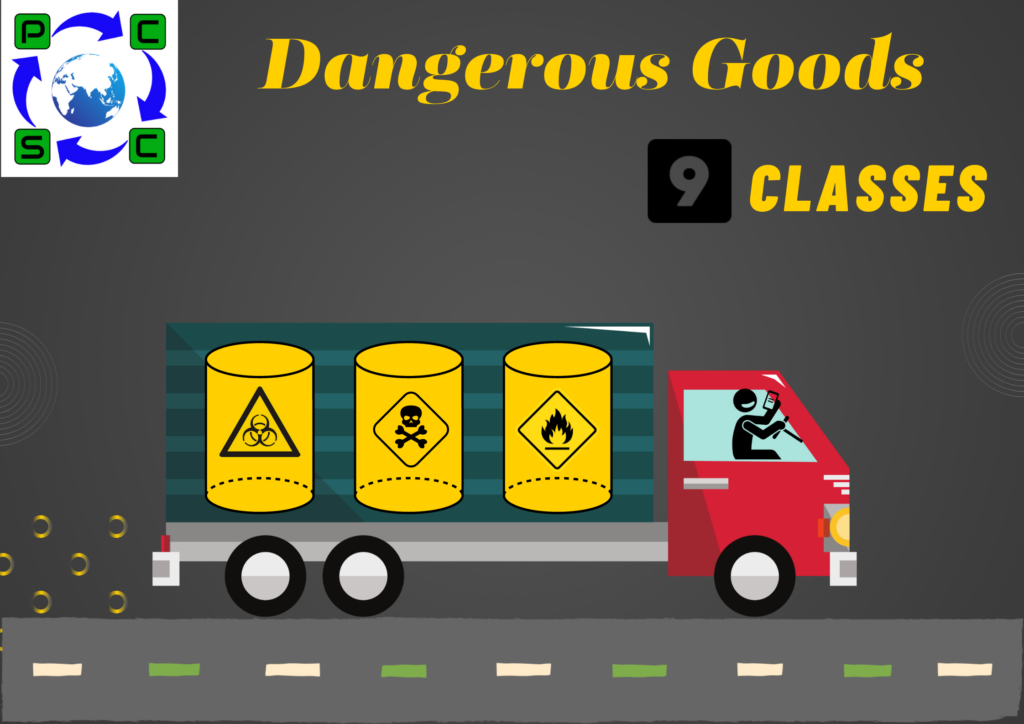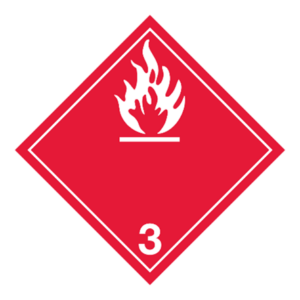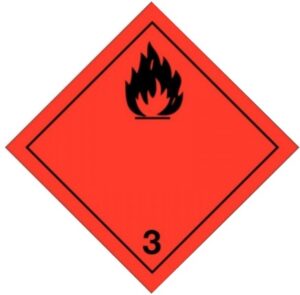Introduction: –
Dangerous goods are subject to transport, workplace, storage, consumer, and environment protection regulations, to prevent accidents to persons, property or the environment, to other goods or to the means of transport employed.

UN Model Dangerous Goods for Transport Labels
The United Nations has developed methods for the harmonization of hazard classification criteria and communication tools, as well as for transport conditions for all modes of transport, to ensure consistency between all these regulatory systems.
In order to effectively execute these systems for the transportation of dangerous products by road, rail, and inland waterways, UNECE also oversees regional agreements.
These labels are from the United Nations Model Rules on the Transport of Hazardous Products and aren’t technically a part of the GHS. Nonetheless, they are usually always approved in jurisdictions that have also chosen to use the GHS as their regulatory framework for chemical substance handling safety.
Continue reading to learn what these labels for various categories of risky goods mean: –
Class 1: Explosive Substances or Article
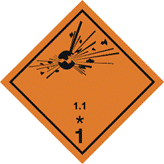
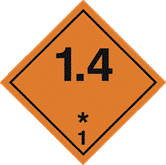
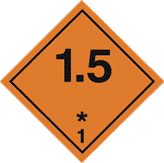
An explosive is any substance or article, including a device or pyrotechnic substance, which is designed to function by explosion (i.e., an extremely rapid release of gas and heat) or which, by chemical reaction within itself, and substances which may be explosive but are very insensitive.
Explosive substances and articles can be classified into one of six divisions, from 1.1 most hazardous to 1.6 least hazardous.
Class 2: – Gases
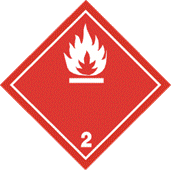


Any material or mixture having in the container an absolute pressure exceeding 40 psi (pounds per square inch) at 70°F, or regardless of the pressure at 70°F, having an absolute pressure exceeding 140 psi at 130°F; or any flammable material having a vapor pressure exceeding 40 psi at 100°F.”
Items in this class are sorted into three divisions:
- Division 2.1 Flammable Gas – Hydrogen Compressed, Ethylene, Butylene, Acetylene, etc.
- Division 2.2 Non-Flammable Gas – Oxygen Compressed, Nitrogen Compressed, etc.
- Division 2.3 Poisonous Gas – Phosgene, Sulfur Tetrafluoride, Insecticide Gasses, etc.
Class 3: – Flammable liquids
A flammable liquid is a liquid having a flash point of not more than 60 °C (140 °F), or any material in a liquid phase with a flash point at or above 37.8 °C (100 °F) that is intentionally heated and offered for transportation or transported at or above its flash point in a bulk packaging. The class also includes liquid desensitized explosives.
Class 4: – Flammable solids; substances liable to spontaneous combustion; substances which, in contact with water, emit flammable gases.
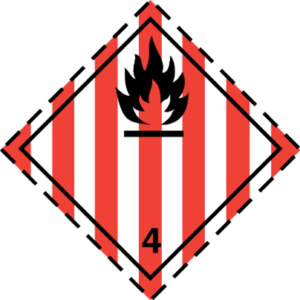
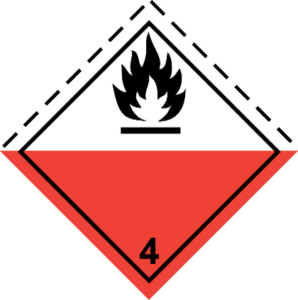
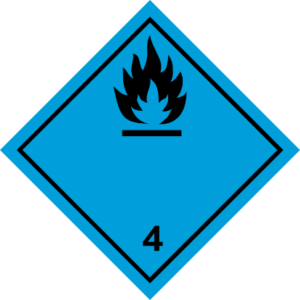
A “solid, other than a blasting agent or explosive, that is liable to cause fire through friction, absorption of moisture, spontaneous chemical change, or retained heat from manufacturing or processing, or which can be readily ignited and when ignited, burn so vigorously and persistently to create a serious hazard,” is referred to as a flammable solid. Gun powder is an illustration of a flammable solid.
Flammable solids are further broken down into three divisions:
- Division 4.1 Flammable Solids – Indicated by red and white striped label, covers flammable solids, self-reactive substances.
- Division 4.2 Spontaneously Combustible – Indicated by red and white bisected label specifies substances which will ignite within five minutes upon contact with air.
- Division 4.3 Dangerous When Wet – Indicated by the blue label, covers substances which evolve into flammable gases after encountering water.
Class 5: – Oxidizing substances and organic peroxides
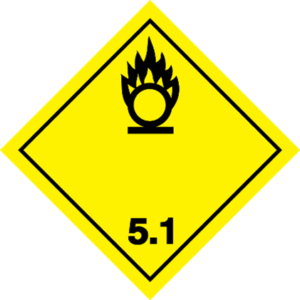
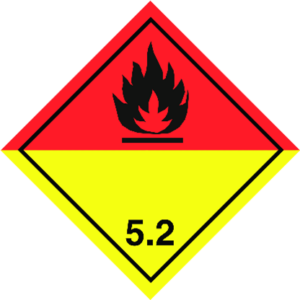
Hazard Class 5 consists of two divisions:
- Division 5.1 Oxidizing Substances – This is indicated on the label by a flame over a circle. A material that may, generally by yielding oxygen, cause or enhance the combustion of other materials.
- Division 5.2 Organic Peroxides – Indicated by a red and yellow bisected label with a flame, categorises organic peroxides. Any organic compound that contains oxygen in the bivalent -O-O- structure and that may be considered a derivative of hydrogen peroxide.
These are thermally unstable materials that could burn, explode, or interact hazardously with other materials.
Class 6: -Toxic substances and infections substances

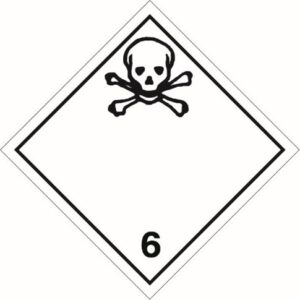
Hazard Class 6 consists of two divisions:
- Division 6.1 Toxic substances – Indicated with skull and crossbones on the label, which have the potential to result in human illness, serious injury, or death. This might happen via ingesting, inhalation, or skin contact.
- Division 6.2 Infectious substances – Indicated by a label with three crescents on top of a circle. These are known or expected to contain disease-causing pathogens.
Class 7: – Radioactive material
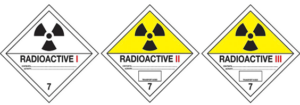
Radioactive material is defined as any material containing radionuclides where both the activity concentration and the total activity exceeds certain pre-defined values.
Depending on the class category, there are three different ways that substances are labelled (assigned by maximum dose rate). A white label with a black trefoil symbol and a single red vertical bar is used for Category I. Both category II and category III use a label that is yellow and white in half and has two or three red bars, as required.
Class 8: – Corrosive Substances

Materials of this nature are visualised on a black and white bisected label, with a hand and a metal surface being corroded from a liquid substance.
Corrosive substances are those that, through chemical action, will permanently harm the skin or, in the event of a leak, will significantly harm or even completely destroy other items or a vehicle.
Class 9: Miscellaneous dangerous substances and articles, including environmentally hazardous substances.

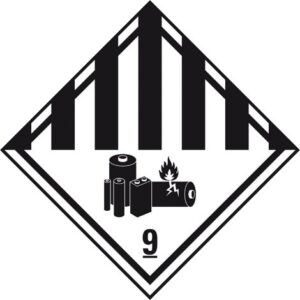
Miscellaneous dangerous goods are indicated by a white label with 7 vertical black stripes in the upper half.
Substances and articles in this class include, but are not limited to: asbestos, lithium batteries, capacitors, life-saving appliances, ammonium nitrate-based fertilisers, genetically modified organisms and microorganisms, substances transported at elevated temperatures (liquids above 100°C or solids above 240°C), and environmentally hazardous substances.
Also, it serves as a catch-all category for items or substances that pose a risk during transport but do not fit into any other categories.
Source: –
https://unece.org/transport/dangerous-goods
https://unece.org/sites/default/files/2021-09/ST-SG-AC10-1r22e_Vol2_track_WEB.pdf








 Authorised IMDS & CDX Training & Consulting partner for
Authorised IMDS & CDX Training & Consulting partner for







